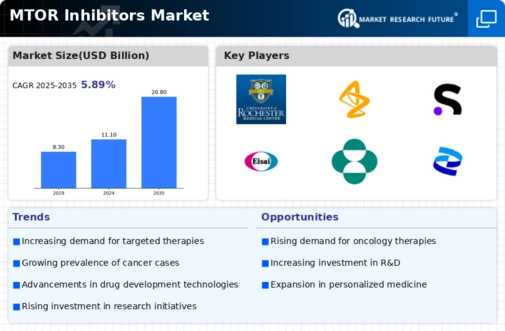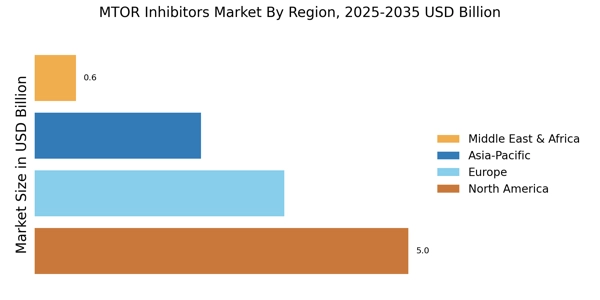Rising Incidence of Cancer
The increasing prevalence of cancer worldwide is a primary driver for the MTOR Inhibitors Market. Cancer remains one of the leading causes of mortality, with millions diagnosed annually. The demand for effective treatment options has surged, leading to a heightened focus on targeted therapies, including MTOR inhibitors. These agents have shown promise in treating various malignancies, particularly renal cell carcinoma and breast cancer. According to recent statistics, the cancer therapeutics market is projected to reach substantial figures, with MTOR inhibitors playing a pivotal role in this growth. As healthcare systems strive to improve patient outcomes, the integration of MTOR inhibitors into treatment regimens is likely to expand, further propelling the market forward.
Advancements in Drug Development
Innovations in drug development methodologies are significantly influencing the MTOR Inhibitors Market. The advent of advanced technologies, such as high-throughput screening and computational drug design, has accelerated the discovery and optimization of MTOR inhibitors. These advancements enable researchers to identify novel compounds with enhanced efficacy and reduced side effects. Furthermore, the increasing investment in research and development by pharmaceutical companies is likely to yield a pipeline of new MTOR inhibitors, catering to unmet medical needs. The market is expected to witness a surge in new product launches, which could enhance competition and drive growth. As a result, the MTOR inhibitors segment is poised for expansion, reflecting the ongoing commitment to innovation in cancer therapeutics.
Regulatory Support for Oncology Drugs
Regulatory bodies are increasingly supportive of the development and approval of oncology drugs, including MTOR inhibitors, which is a significant driver for the MTOR Inhibitors Market. Streamlined approval processes and incentives for innovative therapies are encouraging pharmaceutical companies to invest in the development of new MTOR inhibitors. The introduction of expedited review pathways and orphan drug designations for rare cancers has further facilitated market entry for these agents. As regulatory frameworks evolve to accommodate the growing need for effective cancer treatments, the MTOR inhibitors segment is likely to benefit from enhanced market access. This supportive environment may lead to an influx of new products, thereby expanding treatment options for patients and driving market growth.
Growing Awareness of Targeted Therapies
The rising awareness and acceptance of targeted therapies among healthcare professionals and patients are propelling the MTOR Inhibitors Market. As more individuals become informed about the benefits of personalized medicine, the demand for targeted treatment options is likely to increase. MTOR inhibitors, known for their ability to selectively inhibit tumor growth, are gaining traction as viable alternatives to traditional chemotherapy. Educational initiatives and clinical guidelines promoting the use of these therapies are contributing to their adoption in clinical practice. Market data suggests that the segment of targeted therapies is experiencing robust growth, with MTOR inhibitors at the forefront. This trend indicates a shift in treatment paradigms, emphasizing the importance of tailored approaches in oncology.
Increasing Investment in Cancer Research
The surge in investment directed towards cancer research is a crucial driver for the MTOR Inhibitors Market. Governments, private organizations, and philanthropic entities are allocating substantial funds to advance cancer research initiatives. This financial support is fostering innovation in the development of MTOR inhibitors, as researchers explore novel applications and combinations with other therapies. The emphasis on collaborative research efforts is likely to yield promising results, enhancing the understanding of MTOR signaling pathways and their role in cancer progression. Market analysts project that this influx of funding will lead to breakthroughs in treatment strategies, ultimately benefiting the MTOR inhibitors segment. As research continues to evolve, the market is expected to expand, reflecting the commitment to combating cancer through targeted therapies.


















Leave a Comment